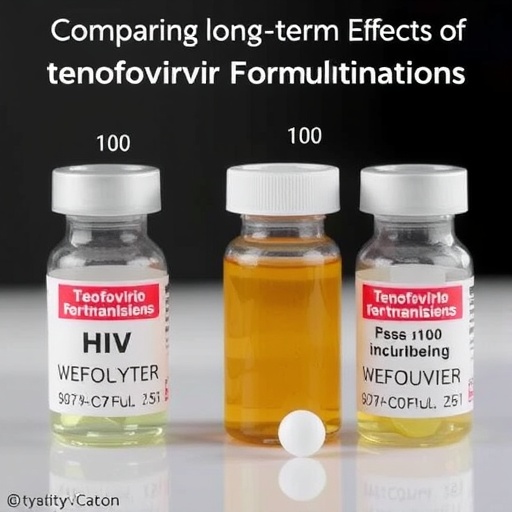In recent years, the landscape of antiretroviral therapy (ART) for HIV has undergone significant transformations, largely driven by the introduction of more effective and safer drug options. Among these, two formulations of tenofovir, namely tenofovir alafenamide (TAF) and tenofovir disoproxil fumarate (TDF), have attracted considerable attention due to their differing pharmacokinetic properties and safety profiles. A groundbreaking study by Karabay et al. sheds light on the long-term metabolic effects and safety of these drugs in ART-naive individuals living with HIV, marking a critical advancement in our understanding of HIV treatment modalities.
The study, which employs a multicenter retrospective design, utilizes a mixed-effects model to analyze data from a diverse group of participants. This innovative methodological approach allows for a comprehensive examination of the metabolic impacts of TAF and TDF over an extended period, providing insights that are not only relevant to clinical practice but also to public health policies aimed at managing HIV effectively. The choice of a retrospective study design is particularly compelling, as it enables researchers to gather and analyze historical data, thereby maximizing the use of existing resources in a manner that can yield rich, informative outcomes.
One of the key findings of the study is the differential metabolic impact exhibited by TAF and TDF. It has long been suspected that TAF, due to its lower nephrotoxicity and more favorable lipid profiles, might offer a more advantageous option for long-term use. In contrast, TDF has been associated with greater risks of renal impairment and bone density loss. By incorporating a mixed-effects analytical approach, Karabay et al. provide a nuanced understanding of these effects, contributing vital information that can inform treatment decisions for HIV-positive patients.
The authors meticulously collected data on various metabolic parameters, including renal function, lipid levels, and bone mineral density, to paint a comprehensive picture of how these two drugs fare over time. Their analysis reveals a concerning trend associated with TDF, which demonstrates a more pronounced decline in renal function when compared to TAF. This is particularly salient given that many patients face the dual challenge of managing HIV while avoiding comorbidities that stem from ART itself.
Furthermore, the study explores the safety profiles of both medications, drawing attention to important side effects that may influence patient adherence to treatment regimens. Poor adherence has long been recognized as a significant barrier to effective HIV management, and understanding the safety profiles of different ART options is paramount in ensuring long-term treatment success. By highlighting the increased incidences of adverse events related to TDF, the study effectively advocates for more personalized treatment approaches that take into account individual patient needs and potential drug-induced complications.
Another remarkable aspect of the study is its multicenter design, which enriches the data quality by incorporating a heterogeneous sample of participants. This diversity enhances the generalizability of the findings, making them applicable to a broader population of ART-naive individuals living with HIV. Such robust epidemiological data is crucial for understanding how different demographic factors—such as age, sex, and comorbidities—interact with drug efficacy and safety, ultimately guiding clinicians in optimal prescribing practices.
As the ongoing fight against HIV continues, studies like this play an essential role in shaping the future of ART. The increasing availability of treatment options must be tempered by a meticulous evaluation of their long-term effects on populations that have historically been underserved. By contrasting the metabolic and safety profiles of TAF and TDF, Karabay et al. open the door to more informed discussions about which patients may benefit from specific drugs, thereby fostering a more effective and compassionate approach to HIV treatment.
The implications of these findings extend beyond the clinical realm, resonating throughout public health initiatives aimed at preventing the spread of HIV and improving the quality of life for those affected. As healthcare systems around the world grapple with the demands of treating HIV, the findings from this study reinforce the necessity of integrating pharmacovigilance and personalized medicine into HIV care strategies.
Moreover, the growing body of evidence supporting TAF’s safety and tolerability may influence the future pharmaceutical landscape. Drug manufacturers and policymakers may take heed of this study, prompting further research into alternative formulations and novel therapeutic strategies aimed at maximizing patient outcomes. As the understanding of HIV treatment evolves, so too must the approaches we use to educate patients about their options.
In conclusion, the work done by Karabay et al. represents a significant stride in our understanding of the long-term implications of utilizing TAF and TDF within the intended population. The outcomes of this extensive study provide critical insights that not only enhance clinical practice but also lay the groundwork for future explorations in the realm of HIV treatment. The journey toward eradicating HIV is ongoing, but evidence-based research continues to illuminate the paths we may take toward achieving this global health objective.
As we reflect on these findings, it becomes clear that the battle against HIV is multifaceted, requiring concerted efforts from researchers, healthcare providers, and patients alike. By fostering a culture of inquiry and embracing the lessons learned from studies such as this, the medical community can continue to enhance the standards of care for those living with HIV, thereby improving outcomes and ultimately saving lives.
Subject of Research: Long-term metabolic and safety profiles of tenofovir alafenamide and tenofovir disoproxil fumarate in ART-naive people living with HIV.
Article Title: Long-term metabolic and safety profiles of tenofovir alafenamide and tenofovir disoproxil fumarate in ART-naive people living with HIV: a multicenter retrospective study using a mixed-effects model.
Article References:
Karabay, O., Vatan, A., Ucar, A. et al. Long-term metabolic and safety profiles of tenofovir alafenamide and tenofovir disoproxil fumarate in ART-naive people living with HIV: a multicenter retrospective study using a mixed-effects model.
BMC Pharmacol Toxicol 26, 164 (2025). https://doi.org/10.1186/s40360-025-01003-0
Image Credits: AI Generated
DOI:
Keywords: HIV, antiretroviral therapy, tenofovir alafenamide, tenofovir disoproxil fumarate, metabolic profile, safety profile, ART-naive individuals, multicenter study.




